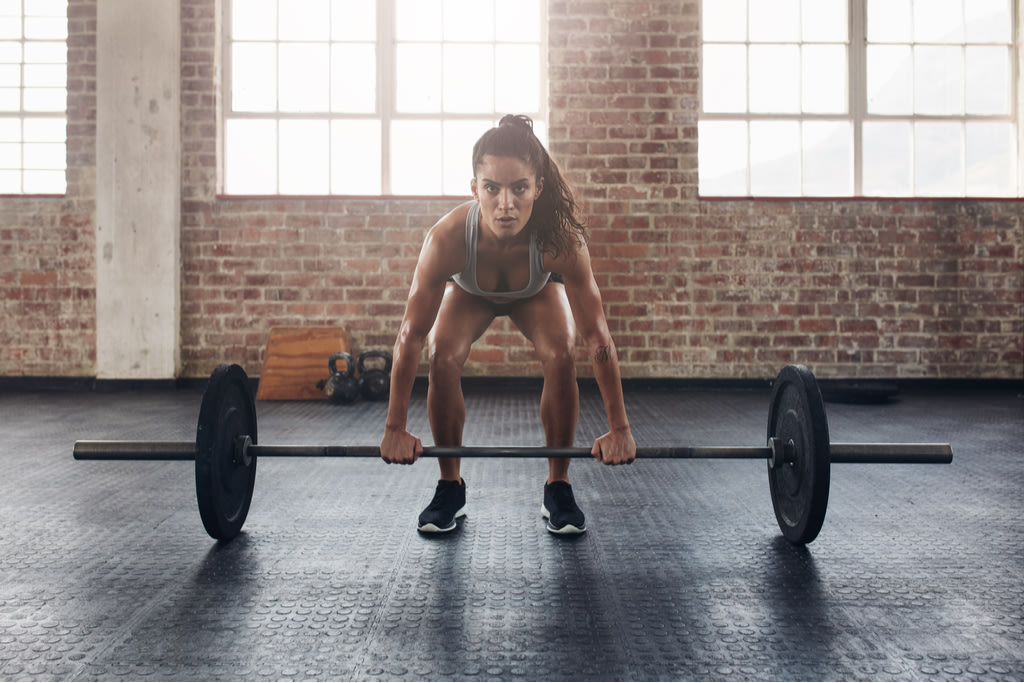Perfect Your Form: How To Do A Deadlift

November 26, 2019

Love ’em or hate ’em, there’s no denying the power of deadlifts. They’re not only a great test of physical and mental strength but work more muscles than almost any other exercise. We love that.
Deadlifts are an incredible tool for muscle building and full-body conditioning and feature in several Sweat programs such as BUILD, Strength & Sculpt, PWR and High Intensity Strength.
Here, we’ll explain why we’re such big fans of this exercise and give you the lowdown on everything from how to perform a deadlift with proper form to tips on how to improve your focus and form.
So, whether you’re new to lifting or an experienced gym-goer, you’ll feel ready to step up to the bar and get lifting. Let’s go!
What is a deadlift?
A deadlift is a full-body exercise where you stand with your feet shoulder-width apart and lift a barbell (loaded with your chosen weights) up to your hips and back to the ground. You can also perform deadlifts with dumbbells or a kettlebell.
Because deadlifts are a compound exercise, meaning they engage multiple major muscle groups at once, they are incredibly popular with those who are serious about increasing their strength.
What muscles do deadlifts work?
When you perform a deadlift you’re working your whole posterior chain, which is the group of muscles that run down the back side of your body, such as your hamstrings, glutes, back and traps. Your arms and core are also engaged as you lift the bar off the ground, supporting your posture and protecting your spine.
Whether you’re a seasoned lifter and deadlifts are a regular part of your routine or it’s your first time attempting this lift, getting your form right is essential if you want to get the most out of the movement and avoid injury.
How to perform a deadlift
When it comes to lifting of any kind, your technique is extremely important, especially when you start to load up the weight.
Doing deadlifts in front of a mirror, your workout buddy or filming yourself can be extremely helpful to get it right! Form always trumps weight, so if your form isn’t correct or you’re feeling discomfort in muscles that you shouldn’t such as your lower back, opt for lighter weights.
Here’s how to perform a conventional deadlift:
Setting up your deadlift
Stand with your feet shoulder-width apart, in the middle of the barbell. When you look down, the bar should be roughly above your shoelaces.
Bend at the hips and knees, keeping your back straight, and holding the bar in an overhand grip, meaning your palms are facing towards your feet. For a conventional deadlift, your hands should be positioned just outside your knees.
Draw your shoulder blades down and back to push out your chest slightly. Inhale and brace your core.
Performing your deadlift
Using your glutes and hamstrings (the backs of your thighs), push evenly through your feet as you lift the bar off the ground and extend your hips and legs to find a neutral standing position with the bar resting in front of your hips. Make sure you maintain a proud chest as you lift the bar (your spine should not be rounding), and keep your head in line with your spine.
Bend at the hips to lower the bar back to the ground and once the bar reaches knee height, bend your knees to return to the starting position. Keep the bar close to your shins as you lower it, keep your knees behind your toes, and finish with the bar above your shoelaces as you started.
Remember to maintain a proud chest and check that your head is in line with your spine.
Why you should deadlift
Aside from being an effective compound exercise that engages multiple major muscle groups at once, unlike isolation exercises like leg extensions or bicep curls, deadlifts are a great way to include progressive overload in your routine. This means you’ll be able to increase your weight significantly over time, track your numbers and celebrate your progress.
Deadlifts are also a very functional exercise, meaning they mimic movements you perform in everyday life like picking heavy items, pets or children up off the ground.
Always check the recommendations in the Sweat app when it comes to increasing your weights and put your safety first! It’s never worth compromising your performance and risking an injury by going too hard or overexerting yourself.
Bad deadlift form: What you need to know
Even experienced gym-goers slip up from time to time when it comes to technique, so it’s important to remember the deadlifting basics and common mistakes that can lead to bad deadlift form. Here are a few things to keep in mind to make sure you’re lifting with proper form and continue to see progress!
Protect your spine: One of the most common deadlift mistakes, especially when the weight feels heavy, is to let your spine curve as you’re lifting the weight off ground. This is a big no-no and a recipe for a back injury. If you feel your spine rounding or you’re feeling it in your lower back, reduce the weight.
Focus on your form over your weight: We’ve said it already and we’ll say it again - it’s SO important to get your technique right. Pay attention to the way you’re lifting and take your time to perform each lift and lower. Closely follow the exercise demonstration videos in the Sweat app if you need help, or ask a gym staff member for guidance. If the weight feels too heavy, go lighter. If it still doesn’t feel right, try a substitute exercise!
Get your head in the game: Think heavy lifting only comes down to physical strength? Think again. A big part of lifting weights is your mental strength, focus and confidence. As you approach the bar, visualise yourself successfully completing the lift. Breathe, trust in your abilities and focus on using the correct muscles.
Incorrect setup: The placement of your feet and the bar can make a big difference. You want the bar to be moving almost straight up and down, so keeping the bar close to your shins is important to avoid any swinging motions or poor posture.
Don’t always train at your max: As much as we love a PB when it comes to weightlifting, you shouldn’t be aiming for one in every single session. Progressive overload is a process and takes patience and consistent training, alongside enough rest days and recovery sessions between intense sessions.
For example, in Sweat’s BUILD program, you’ll find one session per week is reserved for heavy deadlifts and other sessions throughout the week focus on variations.
Be patient: Strength training requires patience, consistency and hard work. Upping your deadlift weights over time is certainly possible, but it’s not going to happen overnight. Good things take time. Stick with your training, track your weights and you’ll get there!
Different types of deadlifts
You’ll find various types of deadlifts throughout a number of Sweat programs. The three most common are conventional, sumo and trap bar deadlifts.
Conventional deadlifts
Conventional deadlifts are performed with your feet roughly shoulder-width apart and toes facing forwards. Your hands are placed on the bar just outside your knees. Conventional deadlifts are great for working multiple muscles, including your hamstrings, glutes, lats and traps.
Sumo deadlifts
In a conventional deadlift your feet are placed shoulder-width apart, while in a sumo deadlift they’re much further apart like a sumo squat, with your toes slightly turned out and your hands holding the bar in between your knees.
Sumo deadlifts are more challenging for your quads and glutes and put less pressure on your back.
Trap bar deadlifts
If you’re new to deadlifting and want additional support to get a feel for how the movement should feel, trap bar deadlifts are a great option.
This bar encourages your body to be in a more upright position, which reduces the pressure on your lower back and shortens the range of motion, making the technique easier to master.
Other types of common deadlifts
You may see other types of deadlifts in your program, like Single-Arm Deadlifts, Single-Leg Romanian Deadlift & Crunch, Kettlebell Deficit Sumo Deadlifts, Half Romanian Deadlifts and Smith Machine Deadlifts. The choice of deadlift is really up to you.
Alternate or mixed grip
If grip strength during deadlifts is a challenge, you can also try an alternate or mixed grip. This means one hand is in an overhand grip position with your palm facing towards your body, and the other hand is in an underhand grip position with your palm facing away from your body.
Build your muscles with deadlifts!
No matter what stage you’re at in your weightlifting journey deadlifts are an incredible exercise to include in your routine - they offer so many unique benefits and it’s so satisfying to see your strength improve!

A more empowered you starts with Sweat, and our editorial team is here to bring you the latest fitness tips, trainer recommendations, wellbeing news, nutritional advice, nourishing recipes and free workouts.
* Disclaimer: This blog post is not intended to replace the advice of a medical professional. The above information should not be used to diagnose, treat, or prevent any disease or medical condition. Please consult your doctor before making any changes to your diet, sleep methods, daily activity, or fitness routine. Sweat assumes no responsibility for any personal injury or damage sustained by any recommendations, opinions, or advice given in this article.
Fitness